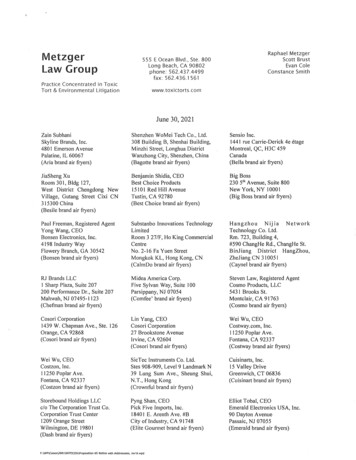![[Bruce M. Metzger] Manuscripts Of The Greek Bible(BookZZ )](/img/16/metzger-1991.jpg)
Transcription
MANUSCRIPTSOF THEGREEK BIBLEAn Introduction to Greek PalaeographyBYBRUCE M. METZGERGeorge L. Collord Professor ofNew Testament Language and LiteraturePrinceton Theological SeminaryNEW YORKOXFORDOXFORD UNIVERSITY PRESS
IVThe Making of Ancient Books§g.THE MATERIALS OF ANCIENT BOOKSTHE materials most widely used for making books in Graeco-Roman antiquitywere papyrus and parchment. Of the two, papyrus was by far the more highlyregarded. 'Civilization--or at the very least, human history-depends on the useof papyrus,' remarked the Roman antiquarian Pliny the Elder describing themethod of manufacture of this writing material. 22 In his day no fewer than ninevarieties in size and grade of papyrus sheets were available in the marketplace.Papyrus is an aquatic plant of the sedge family that grew abundantly in theshallow waters of the Nile in the vicinity of the delta. When mature the plant,which resembles a stalk of corn (maize), was harvested and the stem cut into sections twelve to fifteen inches in length. Each of these was split open lengthwiseand the core of pith removed. After the pith was sliced into thin strips, these tapelike pieces were placed side by side on a flat surface, and another layer placedcrosswise on top. The two layers were then pressed firmly together until theyformed one fabric-a fabric which, though sometimes so brittle now that it canbe crumbled into powder, once had a strength equal to that of good, hand-madepaper. 23Somewhat more durable as writing material was parchmenV4 This was madefrom the skins of sheep, calves, goats, antelopes, and other animals. The youngerthe animal, the finer was the quality of skin. Vellum was the finest quality of extrathin parchment, sometimes obtained from animals not yet born. After the hairhad been removed by scraping, the skins were washed, smoothed with pumice.and dressed with chalk. Before the parchment sheet was used for writing, the horizontal lines as well as the vertical margins were marked by scoring the surface20 'Cumchartae usu maxime humanitas vitaeconstet, certe memoria,' Natural History, xiii, 21 (68);cf. also Karl Dziatzko, Untersuchungen iiber ausgewiihltePergamum, a city of Asia Minor (cf. Rev. 2: 19). Plinythe Elder (Nat. Hist. XIIl.xxi.68-xxvii.83) tells usthat rivalry between King Ptolemy of Egypt and KingEumenes of Pergamum in enlarging their respectivelibraries prompted the former to put an embargo onthe export of papyrus, whereupon the Pergamenes'discovered' parchment. Actually, however, parchmenthad been used as writing material long before the altercation reported by Pliny. Cf. Karl Luthi, Das Pergament. Seine Geschichte, seine Anwendung (Bern, 1938);R. R. Johnson, 'Ancient and Medieval Accounts of the"Invention" of Parchment,' California Studies in ClassicalAntiquiry, iii (1970), pp. 115-22; Ronald Reed, AncientSkins, Parchments, and Leathers (Studies in Archaeological Sciences; London and New York, 1972); and idem,The Nature and Making of Parchment (Leeds, (975).Kapilel des anliken Buchwesens; mit Text, Ubersetzung undErkliirung von Plinius, Nat. Hist. xiii, 168-69 (Leipzig,1900); Alfred Lucas, Ancient Egyptian Materials and Industries, 4th ed. (London, (962), pp. 137-40; Ian V.O'Casey, The Nature and MakingPapyrus (Bal'kstonAsh, Yorkshire, 1973); and Naphtali Lewis, Papyrus inClassical(Oxford, 1974).'3 On the relatively great durability of papyrus, seeT. C. Skeat, 'Early Christian Book-Production,' TheCambridge Histor:Ji of the Bible, vol. 2, The West from theFathers to the Riformation, ed. G. W. H. Lampe (Cam-bridge, 1969), pp. 59 f.'4 The word 'parchment' is derived from the name14
THE MAKING OF ANCIENT BOOKS15with a blunt-pointed instrument drawn along a rule. It was sufficient to draw thelines on one side of the sheet (usually the flesh-side), since they were visible alsoon the other side. In many manuscripts these guide lines can still be noticed, asalso the pinpricks that the scribe made first in order to guide him in ruling theparchment. Different schools of scribes employed different procedures of ruling,and occasionally it is possible for the modern scholar to identify the place of originof a given manuscript by comparing its ruling pattern (as it is called) with thosein other manuscripts whose place of origin is known. 25Vellum intended for deluxe volumes, perhaps as presentation copies to royalty,would be dyed a deep purple and written with gold and/or silver ink (see Plate 20).Ordinary books were written with black or brown ink (§ I I) and sometimeshad decorative headings and initialletters36 colored with blue or yellow or (mostoften) red ink-whence the word 'rubric,' from ruber, the Latin word for 'red.'The advantages of parchment over papyrus for the making of books seem obvious to us today. It was somewhat tougher and more durable than papyrus, whichdeteriorates faster in a damp climate. Moreover, parchment leaves could receivewriting without difficulty on both sides, whereas the vertical direction of the fiberson the verso side of a sheet of papyrus may have made that side less satisfactorythan the recto as a writing surface. Finally, parchment had an advantage overpapyrus in that it could be manufactured anywhere.On the other hand, parchment also had its disadvantages. For one thing, theedges of parchment leaves are liable to become puckered and uneven. Furthermore, according to the observation of Galen,2 7 the famous Greek physician of thesecond century A.D., parchment, which is shiny, strains the eyes of the reader morethan does papyrus, which does not reflect so much light.During the Middle Ages the Arabs learned the technique of making paper fromrags. Although less strong than parchment or vellum, paper was more supple andcheaper. By the twelfth and thirteenth centuries paper manuscripts became moreand more numerous.§IO. THE FORMAT OF ANCIENT BOOKSTHERE were two main forms of books in antiquity. The older form was the roll.This was made by fastening sheets of parchment or papyrus together side by side,and then winding the long strip around a dowel of wood, bone, or metal, thusproducing a volume (a word derived from the Latin volumen, meaning 'something's Kirsopp and Silva Lake identify 175 ruling patterns in their Dated Grule Minuscule ManusCTipts 10 therear 1200 A.D. (Monumenta Palaeograpbica Vetera,First Series, Parts I-X; Boston, 1934-1939); this number is increased to 800 patterns in J. Leroy, Les Typesde rlglure des manuscrits grecs (Paris, 1976). cr. also Leroy,'La description codicologique des manuscrits grecs deparchemin,' in La paUograpnie grecque et(Paris,1977), pp. 27-44·.; For decorated letters see C.'Les initialsdans les manuscrits byzantinesaux XI"-XU" s.,'xxviii (1967), pp.336-54, and especially Carl Nordenfalk, Die spatantikenZierhuchstaben, 2 vols. (Stockholm, 1970).For examples of decorated initials in the presentvolume, see Plates 33 and 40 21 Opera, iii, p. 776. and xviii, p. 630 (ed. C. G.Kuhn).
16MANUSCRIPTS OF THE GREEK BIBLErolled up'). The writing-was placed in columns, each about 2 U to 3U inches widerunning at right angles to the length of the writing surface. Usually only one sideof the writing surface was utilized.The maximum average length of such a roll was about thirty-five feet;'s anything longer became excessively unwieldy to handle. Ancient authors thereforewould divide a lengthy literary work into several 'books,' each of which could beaccommodated in one roll.The other common form of books in antiquity was the codex, or 'leaf-book.'This was made from either parchment or papyrus in a format resembling modernbooks. A certain number of sheets,'9 double the width of the page desired, werestacked on top of one another and folded down the middle. It is obvious that agiven number of sheets will produce twice the number of leaves and four timesthe number of pages. The system of four sheets/eight leaves/sixteen pages eventually became the standard format, and from the Latin word quaternio, meaning "aset of four,' was derived the English word 'quire'-which has come to be used(against its etymology) for a gathering, whatever the number of sheets.At first, most codices were made in single-quire format. 3o The disadvantages ofsuch a format are obvious. Besides being pudgy and somewhat clumsy to use, asingle-quire codex tends to break at the spine. Furthermore, if the book is to havean even appearance when it is closed, it must be trimmed along the fore-edge,and this results in the pages at the middle of the book being narrower than thoseon the outside. For these reasons scribes eventually found it to be more advantageous to assemble a number of smaller quires and to stitch them together atthe back.There was an art connected with the manufacture of such codices. Since thehair-side of parchment is slightly yellower inthan the flesh-side, the aesthetically-minded scribe was careful to place the sheets in such a way that wherever the codex was opened the flesh-side of one sheet would face the flesh-side ofanother sheet, and the hair-side face hair-side. Similarly, in making a papyruscodex careful scribes would assemble sheets of papyrus in such a sequence thatthe direction of the fibers of any two pages facing each other would run eitherhorizontally or verticallyY. So F. G. Kenyon, 'Book Division in Greek andLatin Literature,' William Warner Bishop, A Tribute,ed. by Harry M. Lydenberg and Andrew Keogh (NewHaven, 1941), pp. 63-75; esp. p. 68., The sheets for a papyrus codex were usually obtained by cutting them to a given size from a long rollof papyrus writing material, the roll having been previously manufactured by gluing together sheets of astandard size (kallemata). Today the joins (kolleseis)from the roll of material are sometimes visible in thepages of a codex. See James M. Robinson's detaileddiscussion, 'On the Codicology of the Nag Hammadi Codices,' us textes de Nag Hammadi . , ed. byJacques-E. Ml:nard (Leiden, 1975), pp. 15-31; idem,'The Manufacture of the Nag Hammadi Codices,'Essays on the Nag Hammadi Texts in Honour of PaharLabib, ed. by Martin Krause (Leiden, 1975), pp. 170go; and idem, 'The Future of Papyrus Codicology,'The Future of Coptic Studies, ed. by Robert MeL. Wilson(Leiden, 1979), pp. 23-70, esp. 23-27.30 For a list of single-quire codices, see Eric G.Turner, Till Typology of the Early Codex (Philadelphia,1977), pp. 58--{io.JJ On recto and verso in manuscripts, sec E. G.Turner, The Terms Recto and Verso; the Anatomy of lhePapyrus Roll (Actes du XV·International dePapyrologie, Premiere Partie; Papyrologica Bruxellensia, 16; Brussels, 1978).
THE MAKING OF ANCIENT BOOKS17I t is obvious that the advantages of the codex form of book greatly outweighthose of the scroll. The Church soon found that economy of production (sinceboth sides of the page were used) as well as ease when consulting passages (no needto unroll the more cumbersome scroll) made it advantageous to adopt the codexrather than the scroll for its sacred books. It may be, also, that the desire to differentiate the external appearance of the Christian Bible from that of Jewishscrolls of the synagogue was a contributing factor in the adoption of the codexformatYIn the present volume Plates I, 2, and 3 show fragments from rolls; the fragmentin Plate 8 may be from a roll; all the other Plates reproduce pages, or portions ofpages, from codices.§I I. PEN, INK, AND OTHER WRITING MATERIALSFROM time immemorial the Greeks wrote on parchment and papyrus with areed (d.A4}J.Os orsometimes also with a tiny brush. When the stalk of thereed had been thoro1Jghly dried, one end of it was sharpened to a point and slitinto two equal parts. We first hear of the quill pen in the fifth or sixth centuryA.D., but no doubt it was in use before that.The ink (/LEA 411) used by Greek scribes for writing on papyrus was a carbonbase ink, black in color, made from soot, gum, and water. Since this kind of inkdid not stick well to parchment, another kind was devised. One recipe for thissecond kind used nut-galls (oak-galls). These were pulverized and then water waspoured over the powder. Sulfate of iron was afterward added to it, as well as gumarabic. By the fourth century after Christ this type of ink tended to supersedecarbon-based ink even for writing on papyrus. Nut-gall ink in the course of timetakes on a rusty-brown color. The chemical changes it undergoes may, in fact,liberate minute quantities of sulphuric acid that can eat through the writing material (see Plate 20).Other colors of ink were also used. Titles, first lines of chapters, and even wholemanuscripts were sometimes written with red ink. This was made from minerals,either cinnabar ("tllV6.fj4PLS) or minium (/tiATos). Purple ink (7rOPcfJ{,P4) was made ofa liquid secreted by two kinds of gastropods, the murex and the purpura.The writing on some vellum manuscripts is in silver and/or gold letters. Thevellum of these codices is often purple, but sometimes it is white. Such editions deluxe were costly and valuable, and they were usually intended for great dignitariesof church and state. Purple manuscripts that have survived include uncial copiesof the Gospels dating from the sixth century (Gregory-Aland 0, N, tP, and 080)3' See Peter Katz, 'The Early Christians' Use ofCodices instead of Rolls,' Journal of Theological Studies,xliv (1945), pp. 63-5. For a different view see SaulLieberman, Hellenism in Jewish Palutine (New York,1950), Appendix on 'Jewish and Christian Codices,'pp. 203-8, and for a list and discussion of nearly onehundred pre-Constantinian Biblical papyri, see E. A.Judge and S. R. Pickering, 'Biblical Papyri prior toConstantine: Some Cultural Implications of theirPhysical Form,' Prudentia, x (1978), pp. 1-13, especially pp. 5 fr.
18MANUSCRIPTS OF THE GREEK BIBLEand the ninth century (136), and minuscule copies from the ninth and tenth centuries (565 and 1143 respectively). In a remarkable copy of the Gospels datingfrom the fourteenth century, which once belonged to the Medicis (Gregory-Aland16), the general run of the narrative is written in vermillion; the words of Jesusand angels are crimson and occasionally in gold; the words quoted from the OldTestament and those spoken by the disciples are blue; and, finally, the words ofthe Pharisees, Judas Iscariot, and the devil are black.Besides pen and ink, other implements used by ancient and mediaeval scribesincluded a ruler or straightedge (Kavwv) and a stylusor a thin lead diskfor drawing lines on the parchment; a pair of compassesKapKLvoL) for keeping the lines equidistant from each other; a spongefor making erasures and for wiping off the point of the pen; a piece ofpumice stonefor smoothing the nib of the pen as well as roughnesses onthe papyrus or parchment; a penknife ('YXvq,avos or CTjJ.LXl1) to sharpen the pen;and an inkstand (jJ.EXavoooKov or jJ.EXavoooXELoV) to hold the ink.§I2. PALIMPSESTSthe parchment of a manuscript was used a second (or even a third)time. Particularly during a period of economic recession, when the cost of writingmaterials increased, an older, worn-out volume would be used again. The originalwriting was scraped and washed off, the surface re-smoothed, and the new literarymaterial written on the salvaged pages. Such a manuscript is called a palimpsest,which means 'rescraped' (from 7ra.ALV and 1j;1u.J). Several processes have been usedin the attempt to read the almost totally obliterated underwriting. In the nineteenth century certain chemical reagents (such as ammonium hydrosulphide) wereemployed to bring out traces of the ink remaining in the parchment. The twentieth century has seen the use of the ultra-violet lamp and, still more recently, thevidicon camera, which acquires an image of very, very faint writing in digital form,records it on magnetic tape, and then reproduces it by an electro-optical process. 3JOne of the half-dozen or so most important parchment manuscripts containing portions of the Old and New Testaments in Greek is such a palimpsest. Itsname is codex Ephraemi rescriptus, dating from the fifth century.34 In the twelfthcentury it was erased and many of the sheets rewritten with the text of a Greektranslation of thirty-eight treatises or sermons by St. Ephraem, a Syrian ChurchFather of the fourth century. (This is not the only instance when sermons haveSOMETIMES33 For a deS9'iption of the last-mentioned process,see John F. Benton, Alan R. Gillespie, and James M.Soha, 'Digital Image-Processing Applied to the Photography of Manuscripts, with Examples Drawn fromthe Pincus MS of Arnald of Villanova,' Scriptorillm,xxxiii (1979), PP' 40 -55'l4 The under-writing was deciphered and edited byTischendorf (Leipzig, 1843) before the invention ofthe ultra-violet lamp. For a list of additions and corree-tions gained by the use of such a lamp, see Robert W.Lyon, 'A Re-Examination of Codex Ephraemi Rescriptus,' New Testament Studies, v ([958-59), pp. 2607'1. J. Harold Greenlee has given attention to theunder-writing of nine other fragmentary New Testament manuscripts (namely 0103, 0104, 0132, 0134.0135,0209,0245,0246, and 0247); see his Nine UncialPalimpsests of thl Greek New Testament (Studies and Documents, vol. xxxix; Salt Lake City, 1968).
THE MAKING OFBOOKS19covered over the Scripture text!) Sometimes the under-writing of palimpsests wasnot thoroughly expunged, and in these cases, particularly when it happens tostand between the columns of the upper writing, one can decipher it without undue difficulty (see Fig. 9 and Plate 30).The palimpsesting of manuscripts came to be prohibited by the Church. Amongthe canons passed by the Trullan Synod (A.D. 592) for the Quinisext EcumenicalCouncil, the 68th canon forbids the sale of old manuscripts of the Scriptures to{3,{3A.WKa7r'r/A.OL ('book dealers'), or P.VPEY;O[ ('perfumers'), or to any person whatever.
vThe Transcribing of Greek Manuscripts§I3. SCRIBES AND THEIR WORKPto the invention of printing with movable type in the middle of thefifteenth century, each copy of every piece of literature was produced by handa long and painstaking task, fraught with possibilities of introducing accidentalchanges into the text. Books were expensive, for it would take many weeks or evenmonths to finish a handwritten copy of a literary treatise of considerable length.Something of the drudgery of copying can be appreciated from the colophons,or notes, that scribes not infrequently appended at the close of their handiwork.A typical example, found in many non-Biblical manuscripts, expresses relief: 'Astravellers rejoice to see their home country, so also is the end of a book to thosewho toil [in writing].' Other manuscripts close with an expression of gratitude:'The end of the book-thanks be to God!' A traditional colophon that occurs inmore than one manuscript of the ancient classics describes the physiological effectsof copying: 'Writing bows one's back, thrusts the ribs into one's stomach, andfosters a general debility of the body.' In an Armenian manuscript of the Gospelsa scribal note complains that a heavy snow-storm was raging outside, and thatthe scribe's ink froze, his hand became numb, and the pen fell from his fingers.Along with such colophons reflecting the difficulties and drudgery of copyingmanuscripts, there are others that express the scribe's feeling of satisfaction athaving created an immortal work. A frequently occurring colophon is the couplet:RIORJLEV xdp 'Ypay;auaJLEVEL Els xpovovs 7rA7]pEUTaTovs.('The hand that wrote [this] moulders in a tomb, but what is written abides acrossthe years [lit. to fullest times]'). 3SChristian scribes, for the most part mOhks under the supervision of a prioroften make reference to their unworthiness, describing themselveswith such derogatory epithets as 'least,' 'the very least,' 'poor,' 'wretched,' 'thricewretched,' 'unprofitable,' 'the most clumsy of all men,' 'a sinner,' 'a sinner of allsinners,' 'the greatest of sinners,' and the like. J6 Not infrequently the scribe willadd a prayer to God or Christ to have mercy upon him (see Plates 26, 32, 39,and 43).JS Cf. Gerard Garitte, 'Sur une formule des colophons de manuscrits grecs,' Colleclanea Vaticana inhononm Anselmi M. Card. Albareda, i (Vatican City,[962), PI . 369-9 1 , who lists fifty-one examples of thecolophon. Supplements to Garitte's list were made.bySt. Y. Rudberg, Scriptorium, xx (1966), pp. 66 f.;K. Treu (who added 52 items), ibid., xxiv (1970), pp.56--64; and]. Koder, ibid., xxviii (1974), p. Q95.16 For other epithets of depreciation, see C. Wendel,'Die T'''.VOT'IS des griechisehen Schreibermonches,'By{.antinische Zeitschrift, xliii (1950), pp. 259-66.20
THE TRANSCRIBING OF GREEK MANUSCRIPTS21Two modes of producing manuscripts were in common use in antiquity. According to one procedure, an individual would procure writing material and makea new copy, word by word and letter by letter, from an exemplar of the literarywork desired. It was inevitable (as anyone can see who tries to copy by hand anextensive document) that accidental changes would be introduced into the textas it was transmitted by successive generations of copyists.The accuracy of the new copy would, of course, depend upon the degree of thescribe's familiarity with the language and content of the manuscript being transcribed, as well as upon the care exercised in performing the task. In the earlyyears of the Christian Church, marked by rapid expansion and consequent increased demand by individuals and by congregations for copies of the Scriptures,the speedy multiplication of copies, even by non-professional scribes, sometimestook precedence over strict accuracy of detail. But even for the best trained andmost conscientious scribe, the likelihood of error was compounded by certain features of ancient writing. In uncial Greek script certain letters resemble otherletters, and if the exemplar was worn and the condition of the ink poor, one canunderstand that a scribe might easily confuse the letters E:, a, 0, and c. Such confusion, in fact, accounts for the variant readings os and OEOS (oc and Sc; see §2I)in I Tim. 3:16. In 2 Pet. 2:13 the variant readings ATTATAIC and ArATTAIC arepalaeographicaUy very similar. If ). is written too close to another )., the two canbe mistaken for M-which accounts for the variant readings afJ.a. and a.AAa. in Rom.6:5. The question whether Justus, mentioned in Acts 18:7, was surnamed Titiusor Titus depends on whether one reads TITIOYIOyCTOY or TITOYIOyCTOY. Thecollocation of letters is made still more confusing by the presence of ONOMATI immediately preceding the name.Another possible source of error would confront the scribe when two adjacentor nearly adjacent lines of writing in the exemplar happened to end with the sameword or sequence of letters. In such circumstances the scribe, in looking back tothe exemplar, might inadvertently omit the intervening line or lines. (In technicallanguage, such an error arises from parablepsis, occasioned by homoeoteleuton,or the 'similar ending' of lines.) In 1 John 2:23 the Textus Receptus, followingthe later manuscripts, lacks the words 0 6fJ.OAo,,(wp TOP viop Ka.! TOP 'lra.TEpa. EXEt-anerror that arose when the eye of the scribe mistakenly passed from the wordsTOil 'lra.TEpa. EXEL in the first half of the verse to the same three words at the closeof the verse.The other mode of producing books was that followed at a scriptorium. Herea lector (6.IIa.'YJlWO'T,)S) would read aloud, slowly and distinctly, from the exemplarwhile several scribes seated about him would write, producing simultaneously asmany new copies as there were scribes at work. 37 Although it increased produc37 cr. T. C. Skeat, 'The Use of Dictation in AncientBook-Production,' Procudings of the British Academy,xlii (1956), pp. 196 if.During the Middle Ages scribes would write whileseated at a desk or table; in antiquity, on the otherhand, it appears that they wrote either while seatedand holding the writing material on their knee or lapor sometimes while standing and holding a writingtablet in their hand. For discussions see B. M. Metzger,'When Did Scribes Begin to Use Writing Desks?' Historical and Literary Studies, Pagan, Jewish, and Christian(Leiden and Grand Rapids, 1968), pp. 123-37, and
22MANUSCRIPTS OF THE GREEK BIBLEtivity, dictation also multiplied the types of errors that could creep into a text. Aparticular source of trouble arose from the circumstance that certain vowels cameto be pronounced alike. For example, as was mentioned earlier (§8), in the courseof time the pronunciation of the Greek pronouns of the first and second personsplural became indistinguishable. Consequently, in the New Testament it is sometimes difficult or impossible to decide on the basis of divergent evidence in themanuscripts which form was originally intended by the author.On the whole, however, many such errors in transcription would be caught bythe oLop(Jwr.qs ('corrector') of the scriptorium, who inspected for accuracy the finished work of individual scribes. The corrector's work in a manuscript is usuallyrevealed by different handwriting, different ink, and the 'secondary' placing ofhis work in relation to the principal handwriting. Deletions may be indicated byenclosing a passage in round brackets; by cancelling a letter or letters by meansof a stroke drawn through them; by placing a dot eexpunging dot') above, orbelow, or to either side; or by a combination of these methods (see Plates 7, 33,and 37).§I4. STYLES OF GREEK HANDWRITINGBASICALLY there were two kinds of Greek handwriting and several kinds of letters. The book-hand was the more elegant and formal script, customarily employedfor literary works; the cursive-hand was the everyday script, ordinarily used fornonliterary documents such as letters, accounts, petitions, deeds, receipts, and thelike. The variety of cursive hands was well-nigh infinite; the nonliterary papyritestify to this in a most eloquent way.3 8According to the terminology used by many (though not all J9 ) palaeographers,there were four kinds of Greek letters--capitals, uncials, cursives, and minuscules(see Fig. 2). Capitals, characterized by angularity and straight lines, are used ininscriptions, being cut or engraved on some hard substance, such as stone or metal.Each letter is made separate and distinct from every other letter. Uncials are amodification of capitals, in which curves are freely introduced as being more readin capitals isily inscribed with a pen on parchment or papyrus. For example,written c in uncials. Both capitals and uncials are written as though boundedbetween two horizontal lines that determine the height and the size of the letters,with only one or two projecting above or below. This 'bilinear' quality is particularly noticeable in the calligraphic production of Bibles, in which scribes maintained an extraordinary evenness of script from the first page to the last.G. M. Parassoglou, '.1eEut xdp «cd ,,(/wll. Some Thoughtson the Positions of the Ancient Greeks and RomansWhen Writing on Papyrus Rolls,' Scrittura e civilta, iii(1979), pp. 5-121 38 Referring to Latin hands, E. A. Lowe aptly remarks, 'Cursive script is to calligraphy what dialect isto literary diction' ('Handwriting,' in The Legacy ojthe Middle Ages, ed. by C. G. Crump and E. F.Jacob[Oxford, 1938], p. :205).39 Among present-day palaeographers who do notaccept the traditional terminology are GuglielmoCavallo, who uses 'majuscules' for the category usuallycalled 'uncials,' and E. G. Turner, who restricts theuse of 'uncial' to Latin palaeography (in accord withthe explicit testimony of Jerome; cf. his Praif. in Lib.lao, Migne, Patrologia Latina, xxviii, col. 11412) andwes the term 'capital' for all ancient Greek handwriting in which 'each letter is made by itself, for itself,and stands alone, i.e. is unligatured' (letter dated22 November 1978).
23THE TRANSCRIBING OF GREEK MANUSCRIPTS"'- c.it& "'"""b,S1Q.d"111. E.aa,i,AA AA AA111' r4-/,/\cE'1rrv yvII1ft(1)1ttlf0.'tlII8 HI'" H.0 fIC C!),,.I,1!"'t), fCqlkItTphkh,.60I, . urrr6.).EeeYy,rJ.'"Mrl1N"'N00Z.l.HHe.,;.l1&1\)" Mf1,,&I"i ,"'.NMN""".31100cTTTX It. ". ,'HII'liN31.1. 'l 1 ,p,PU ittCe-re C''t'TTr:rf4»tTw'Ytw.'"xt'"'n7 XlColI2. Development of the Greek alphabet1\.hil.TTxttill""." .uJHhKkkl." . .,'"I'.II' I'.)n'VFIGURBt-nX.Jl"If1'fa0)CnVvtt:u0)(-tw XT'VNHtv.a.J1E Irl .,f.KtAlJ j&KAI"IvhI.Ie"-\., 'I 'hK1:; .4 .I1\yIr L H I"IY'r4. " '''' ",r,vy ""ant tod.-IId 1eaIIT)t0zrn r rn9yHnP""IIItxA9,418 vn"'m4-r.un.MLG.CI'tpClwwlClftt W . ,4d-.-. ,,,,-CUlt1-b.'I'-.b 1'b. 1'-.b-A8.(1) eICKI0IIf0YV,t,I"-.,YIM"'",r",1 II." t., ,.,.,01 I/'cBH B t4hJm.nt&8ct.ui.ceLAi%.qoe.ac.4"1 AAu(31-.-.Gt." ,, l)/I" Nr'lYfa0 n"rpet.cr- CT"t, flP-l.If',Tt rTl-1'.1--ttXfCol
24MANUSCRIPTS OF THE GREEK BIBLEFor daily use this way of writing took too much time, and at an early datecursive writing developed from the uncial and continued to be used concurrentlywith it. Besides being more convenient, cursive letters were often simplified aswell as combined when the scribe would join two or more together without liftingthe pen (ligature). At the beginning of the ninth century a special form of thecursive was developed which came almost immediately into widespread use for theproduction of books, supplanting uncial hands (see §I6).It mllst be borne in mind that most of the books of the New Testament wereoriginally not intended for publication, and others were meant for only a limitedcircle of readers. It is understandable, therefore, that the original of, say, one ofthe New Testament Epistles would have been written in a cursive form of script,quite different in appearance from the earliest known copies of that Epistle whichare extant today.§15.UNCIAL HANDWRITINGFROM the fourth century B.C. till the eighth or ninth century A.D. the book-handchanged very slowly and often harked back t
16 MANUSCRIPTS OF THE GREEK BIBLE rolled up'). The writing-was placed in columns, each about 2 U to 3U inches wide runn










